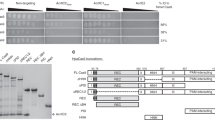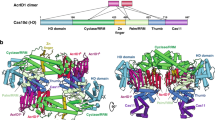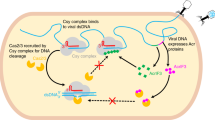Abstract
Phages use anti-CRISPR proteins to deactivate the CRISPR–Cas system. The mechanisms for the inhibition of type I and type II systems by anti-CRISPRs have been elucidated. However, it has remained unknown how the type V CRISPR–Cas12a (Cpf1) system is inhibited by anti-CRISPRs. Here we identify the anti-CRISPR protein AcrVA5 and report the mechanisms by which it inhibits CRISPR–Cas12a. Our structural and biochemical data show that AcrVA5 functions as an acetyltransferase to modify Moraxella bovoculi (Mb) Cas12a at Lys635, a residue that is required for recognition of the protospacer-adjacent motif. The AcrVA5-mediated modification of MbCas12a results in complete loss of double-stranded DNA (dsDNA)-cleavage activity. In contrast, the Lys635Arg mutation renders MbCas12a completely insensitive to inhibition by AcrVA5. A cryo-EM structure of the AcrVA5-acetylated MbCas12a reveals that Lys635 acetylation provides sufficient steric hindrance to prevent dsDNA substrates from binding to the Cas protein. Our study reveals an unprecedented mechanism of CRISPR–Cas inhibition and suggests an evolutionary arms race between phages and bacteria.
This is a preview of subscription content, access via your institution
Access options
Access Nature and 54 other Nature Portfolio journals
Get Nature+, our best-value online-access subscription
$29.99 / 30 days
cancel any time
Subscribe to this journal
Receive 12 print issues and online access
$189.00 per year
only $15.75 per issue
Buy this article
- Purchase on Springer Link
- Instant access to full article PDF
Prices may be subject to local taxes which are calculated during checkout




Similar content being viewed by others
Data availability
The atomic coordinates and structure factors of AcrVA5 have been deposited in the Protein Data Bank under accession code 6IUF. The atomic coordinates of acetylated MbCas12a have been deposited in the Protein Data Bank under accession code 6IV6. The corresponding maps have been deposited in the Electron Microscopy Data Bank under accession code EMD-9742. The data sets generated and analyzed are available from the corresponding authors on request.
References
Makarova, K. S. et al. An updated evolutionary classification of CRISPR-Cas systems. Nat. Rev. Microbiol. 13, 722–736 (2015).
Marraffini, L. A. CRISPR-Cas immunity in prokaryotes. Nature 526, 55–61 (2015).
Westra, E. R. et al. The CRISPRs, they are a-changin’: how prokaryotes generate adaptive immunity. Annu. Rev. Genet. 46, 311–339 (2012).
Sorek, R., Lawrence, C. M. & Wiedenheft, B. CRISPR-mediated adaptive immune systems in bacteria and archaea. Annu. Rev. Biochem. 82, 237–266 (2013).
Ran, F. A. et al. Genome engineering using the CRISPR-Cas9 system. Nat. Protoc. 8, 2281–2308 (2013).
Platt, R. J. et al. CRISPR-Cas9 knockin mice for genome editing and cancer modeling. Cell 159, 440–455 (2014).
Shalem, O. et al. Genome-scale CRISPR-Cas9 knockout screening in human cells. Science 343, 84–87 (2014).
Zetsche, B. et al. Multiplex gene editing by CRISPR-Cpf1 using a single crRNA array. Nat. Biotechnol. 35, 31–34 (2017).
Kleinstiver, B. P. et al. Genome-wide specificities of CRISPR-Cas Cpf1 nucleases in human cells. Nat. Biotechnol. 34, 869–874 (2016).
Tang, X. et al. A CRISPR-Cpf1 system for efficient genome editing and transcriptional repression in plants. Nat. Plants 3, 17103 (2017).
Nishimasu, H. et al. Crystal structure of Cas9 in complex with guide RNA and target DNA. Cell 156, 935–949 (2014).
Yamano, T. et al. Crystal structure of Cpf1 in complex with guide RNA and target DNA. Cell 165, 949–962 (2016).
Bondy-Denomy, J., Pawluk, A., Maxwell, K. L. & Davidson, A. R. Bacteriophage genes that inactivate the CRISPR/Cas bacterial immune system. Nature 493, 429–432 (2013).
He, F. et al. Anti-CRISPR proteins encoded by archaeal lytic viruses inhibit subtype I-D immunity. Nat Microbiol 3, 461–469 (2018).
Pawluk, A. et al. Naturally occurring off-switches for CRISPR-Cas9. Cell 167, 1829–1838 e9 (2016).
Rauch, B. J. et al. Inhibition of CRISPR-Cas9 with bacteriophage proteins. Cell 168, 150–158 e10 (2017).
Dong et al. Structural basis of CRISPR-SpyCas9 inhibition by an anti-CRISPR protein. Nature 546, 436–439 (2017).
Stanley, S. Y. & Maxwell, K. L. Phage-encoded anti-CRISPR defenses. Annu. Rev. Genet. 52, 445–464 (2018).
Gunaratne, R. et al. Patient dissatisfaction following total knee arthroplasty: a systematic review of the literature. J. Arthroplasty 32, 3854–3860 (2017).
Watters, K. E., Fellmann, C., Bai, H. B., Ren, S. M. & Doudna, J. A. Systematic discovery of natural CRISPR-Cas12a inhibitors. Science 362, 236–239 (2018).
Marino, N. D. et al. Discovery of widespread type I and type V CRISPR-Cas inhibitors. Science 362, 240–242 (2018).
Shmakov, S. A. et al. The CRISPR spacer space is dominated by sequences from species-specific mobilomes. MBio 8, e01397-17 (2017).
Heussler, G. E. & O’Toole, G. A. Friendly fire: biological functions and consequences of chromosomal targeting by CRISPR-cas systems. J. Bacteriol. 198, 1481–1486 (2016).
Zhang, F. et al. CRISPRminer is a knowledge base for exploring CRISPR-Cas systems in microbe and phage interactions. Commun. Biol. 1, 180 (2018).
Yang, H. & Patel, D. J. Inhibition mechanism of an anti-CRISPR suppressor AcrIIA4 targeting SpyCas9. Mol. Cell 67, 117–127 e5 (2017).
Salah Ud-Din, A. I., Tikhomirova, A. & Roujeinikova, A. Structure and functional diversity of GCN5-related N-acetyltransferases (GNAT). Int. J. Mol. Sci. 17, E1018 (2016).
Holm, L. & Laakso, L. M. Dali server update. Nucleic Acids Res. 44, W351–W355 (2016).
Magin, R. S., Liszczak, G. P. & Marmorstein, R. The molecular basis for histone H4- and H2A-specific amino-terminal acetylation by NatD. Structure 23, 332–341 (2015).
Yamano, T. et al. Structural basis for the canonical and non-canonical PAM recognition by CRISPR-Cpf1. Mol. Cell 67, 633–645 e3 (2017).
Chowdhury, S. et al. Structure reveals mechanisms of viral suppressors that intercept a CRISPR RNA-guided surveillance complex. Cell 169, 47–57 e11 (2017).
Harrington, L. B. et al. A broad-spectrum inhibitor of CRISPR-Cas9. Cell 170, 1224–1233.e15 (2017).
Maxwell, K. L. et al. The solution structure of an anti-CRISPR protein. Nat .Commun. 7, 13134 (2016).
Bondy-Denomy, J. et al. Multiple mechanisms for CRISPR-Cas inhibition by anti-CRISPR proteins. Nature 526, 136–139 (2015).
Zetsche, B. et al. Cpf1 is a single RNA-guided endonuclease of a class 2 CRISPR-Cas system. Cell 163, 759–771 (2015).
Xiong, B. et al. Genome editing of Ralstonia eutropha using an electroporation-based CRISPR-Cas9 technique. Biotechnol. Biofuels 11, 172 (2018).
Feng, X., Zhao, D., Zhang, X., Ding, X. & Bi, C. CRISPR/Cas9 assisted multiplex genome editing technique in Escherichia coli. Biotechnol. J. 13, e1700604 (2018).
Otwinowski, Z. & Minor, W. Processing of X-ray diffraction data collected in oscillation mode. Methods Enzymol. 276, 307–326 (1997).
McCoy, A. J. et al. Phaser crystallographic software. J .Appl. Crystallogr. 40, 658–674 (2007).
Emsley, P. & Cowtan, K. Coot: model-building tools for molecular graphics. Acta Crystallogr. D 60, 2126–2132 (2004).
Adams, P. D. et al. PHENIX: building new software for automated crystallographic structure determination. Acta Crystallogr. D 58, 1948–1954 (2002).
Mastronarde, D. N. Automated electron microscope tomography using robust prediction of specimen movements. J. Struct. Biol. 152, 36–51 (2005).
Zheng, S. Q. et al. MotionCor2: anisotropic correction of beam-induced motion for improved cryo-electron microscopy. Nat. Methods 14, 331–332 (2017).
Zhang, K. Gctf: Real-time CTF determination and correction. J. Struct. Biol. 193, 1–12 (2016).
Shaikh, T. R. et al. SPIDER image processing for single-particle reconstruction of biological macromolecules from electron micrographs. Nat. Protoc. 3, 1941–1974 (2008).
Zivanov, J. et al. New tools for automated high-resolution cryo-EM structure determination in RELION-3. eLife 7, e42166 (2018).
Grant, T., Rohou, A. & Grigorieff, N. cisTEM, user-friendly software for single-particle image processing. eL ife 7, e35383 (2018).
Kucukelbir, A., Sigworth, F. J. & Tagare, H. D. Quantifying the local resolution of cryo-EM density maps. Nat. Methods 11, 63–65 (2014).
Pettersen, E. F. et al. UCSF Chimera—a visualization system for exploratory research and analysis. J. Comput. Chem. 25, 1605–1612 (2004).
Chen, V. B. et al. MolProbity: all-atom structure validation for macromolecular crystallography. Acta Crystallogr. D 66, 12–21 (2010).
Hovmoller, S., Zhou, T. & Ohlson, T. Conformations of amino acids in proteins. Acta Crystallogr. D 58, 768–776 (2002).
Couvin, D. et al. CRISPRCasFinder, an update of CRISRFinder, includes a portable version, enhanced performance and integrates search for Cas proteins. Nucleic Acids Res. 46, W246–W251 (2018).
Edgar, R. C. PILER-CR: fast and accurate identification of CRISPR repeats. BMC Bioinformatics 8, 18 (2007).
Arndt, D. et al. PHASTER: a better, faster version of the PHAST phage search tool. Nucleic Acids Res. 44, W16–W21 (2016).
Acknowledgements
We thank J. He at the Shanghai Synchrotron Radiation Facility (SSRF) for help with data collection. We thank the Core Facilities at the School of Life Sciences, Peking University, for assistance with negative-staining EM and the Electron Microscopy Laboratory and the cryo-EM platform of Peking University for help with cryo-EM data collection. The computation was supported by the High-performance Computing Platform of Peking University. We thank X. Meng and H. Deng at the Center of Biomedical Analysis, Tsinghua University, for protein MS analysis. We thank J. Chai for critical reading of the manuscript. This research was funded by the National Natural Science Foundation of China grant no. 31825008 and 31422014 to Z.H.; 31700655 to N.L. N.L. is supported by Young Elite Scientists Sponsorship Program by CAST.
Author information
Authors and Affiliations
Contributions
F.Z. and F.Z. conducted bioinformatics analysis. L.D. and X.G. expressed, purified and characterized proteins, and crystallized AcrVA5. Y.Z. and N.L. carried out crystallographic and cryo-EM studies. R.K. and L.Y. performed in vivo experiments. L.D. and X.G. performed biochemical assays. L.D., X.G., Z.H., N.G. and Z.H. wrote the paper. All authors contributed to the manuscript preparation. Z.H. designed the experiments.
Corresponding author
Ethics declarations
Competing interests
The authors declare no competing interests.
Additional information
Publisher’s note: Springer Nature remains neutral with regard to jurisdictional claims in published maps and institutional affiliations.
Integrated supplementary information
Supplementary Figure 1 Bioinformatics approach for discovering anti-CRISPR candidates for the V-A CRISPR-Cas12a system (AcrVAs) and identification of anti-CRISPR genes.
a, Statistics of the type of genomic elements that anti-CRISPRs have been discovered to inhibit type I or II CRISPR-Cas system (based on the anti-CRISPRs collection reported in https://tinyurl.com/anti-CRISPR). b, CRISPRminer pipeline was used to predict the V-A CRISPR-Cas systems (including CRISPR arrays, Cas locus and their (sub)types), find spacers with identifiable proto-spacers target their own prophage regions (self-targeting, ST) or prophage regions on other genomes (non-self-targeting, NST). c, In vitro MbCas12a inhibition assay was used to identify the anti-CRISPRs from 49 purified proteins (49 candidates). MbCas12a was first incubated with anti-CRISPR candidates at 1:8 molar ratio. Then crRNA and dsDNA substrate were added and incubated. The reactions were stopped by adding loading buffer for denaturing gel and the reaction mixtures were run on TBE-Urea polyacrylamide gels and visualized by EB staining. Data shown are representative of three independent experiments. d, Plasmid-targeting assay with 49 gene products (candidates 1-50, except 38) from M. bovoculi 22581 prophage2 in E. coli. Survival (CFU: colony-forming unit) of bacteria was calculated in the presence of candidate and targeted plasmids. Non-targeted plasmid co-transformed with candidate 49 (NT+49), targeted plasmid co-transformed with AcrIIA4 (A4), and only targeted plasmid (-) were controls of the assay. The inhibitory effects of AcrIIA4 and candidate 50 against SpCas9 were also tested by four groups: non-targeted plasmid co-transformed with AcrIIA4 (NT+A4), targeted plasmid co-transformed with AcrIIA4 (A4), targeted plasmid co-transformed with candidate 50 (50) and only targeted plasmid (-). Error bars represent the mean±SD of three biological replicates.
Supplementary Figure 2 Inhibition of MbCas12a by AcrVA4 and AcrVA5.
a, Inhibition assays for MbCas12a by AcrVA4 and AcrVA5. Left panel: crRNA was added to buffer containing MbCas12a following addition of AcrVA4 or AcrVA5. Right panel: MbCas12a was pre-incubated with crRNA before AcrVA4 or AcrVA5 was added. After reaction, the reaction mixtures were loaded onto 8% denature polyacrylamide gels. Molar ratios of an anti-CRISPR protein and MbCas12a are shown at the top of each lane. b, Electrophoretic mobility shift assay (EMSA) was used to test the binding of MbCas12a with crRNA or dsDNA in the presence of anti-CRISPR protein AcrVA4. MbCas12a or MbCas12a (D874A/E968A)-crRNA complex was first incubated with increasing amounts of AcrVA4, then crRNA (upper panel) or fluorophore-labelled dsDNA (middle panel) was added and incubated. Nucleic acid-bound MbCas12a complexes were resolved from free nucleic acid by native gel electrophoresis. CrRNA was visualized by ethidium bromide staining (upper panel), and dsDNA was visualized by a fluorescence imaging machine (600 nm) (middle panel). Coomassie blue staining of AcrVA4 at different molar ratios was shown in lower panel. Molar ratios of MbCas12a:AcrVA4 are shown at the top of each lane. Data shown is representative of three independent experiments.
Supplementary Figure 3 The structures of AcrVA5 and the PAM-interacting domain from LbCas12a.
a, Shown is the result of gel filtration experiment after the reaction of AcrVA5 and crRNA-bound MbCas12a. Top, UV absorbance (280 nm) peaks from size-exclusion chromatography. Bottom, Coomassie blue staining following SDS–PAGE of the peak fractions from gel filtration shown on the top. b, The overall structure of the acetyl-CoA-bound AcrVA5 complex shown in cartoon, and two acetyl-CoA molecules are shown as sticks. The two AcrVA5 molecules in the structure were colored cyan (left) and green (right), respectively. c, Detailed interactions of the PAM base pairs with Lys607. Hydrogen bonds are shown as dashed lines. Recognition of the 5’-TTTA-3’ PAM by LbCas12a (PDB: 5XUS).
Supplementary Figure 4 Workflow of the data processing of the AcrVA5-acetylated MbCas12a in complex with crRNA.
a, A representative cryo-EM image of MbCas12a-crRNA complex. b, Representative class averages of 2D classification of auto-picked particles. Particles included for further processing were indicated by red boxes. c, Workflow of the image processing, including unsupervised and supervised 3D classification, 3D refinement and CTF refinement. See more details in Methods.
Supplementary Figure 5 AcrVA5 inhibits the Cas12a strain with lysine but not arginine for recognition of PAM.
a, Time course of cleavage inhibition assays were used to test the inhibition activities of AcrVA5 against WT and R608K mutant Lb2Cas12a. The reactions were stopped by adding loading buffer for denaturing gel and the reaction mixtures were run on TBE-urea polyacrylamide gels and visualized by ethidium bromide staining. Lb2Cas12a from strain Lachnospiraceae bacterium COE1 denotes a close LbCas12a ortholog (45% identity). b, Time course of cleavage inhibition assays were used to test the inhibition activities of AcrVA5 against WT and K595R mutant LbCas12a. The reactions were stopped by adding loading buffer for denaturing gel and the reaction mixtures were run on TBE-urea polyacrylamide gels and visualized by ethidium bromide staining.
Supplementary information
Supplementary Figures, Supplementary Tables, Supplementary Note and Supplementary Dataset
Supplementary Figures 1–5, Supplementary Tables 1–2, Supplementary Note 1 and Supplementary Dataset 1
Supplementary Dataset 2
MS data of AcrVA5-modified MbCas12a
Rights and permissions
About this article
Cite this article
Dong, L., Guan, X., Li, N. et al. An anti-CRISPR protein disables type V Cas12a by acetylation. Nat Struct Mol Biol 26, 308–314 (2019). https://doi.org/10.1038/s41594-019-0206-1
Received:
Accepted:
Published:
Issue Date:
DOI: https://doi.org/10.1038/s41594-019-0206-1
This article is cited by
-
Eukaryotic-driven directed evolution of Cas9 nucleases
Genome Biology (2024)
-
Structure-guided discovery of anti-CRISPR and anti-phage defense proteins
Nature Communications (2024)
-
Inhibitors of bacterial immune systems: discovery, mechanisms and applications
Nature Reviews Genetics (2024)
-
Insights into the inhibition of protospacer integration via direct interaction between Cas2 and AcrVA5
Nature Communications (2024)
-
Cas12a2 elicits abortive infection through RNA-triggered destruction of dsDNA
Nature (2023)



